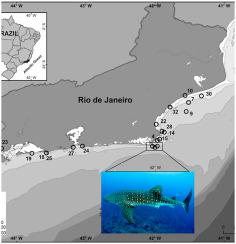Ocean & Coastal Management ( IF 4.8 ) Pub Date : 2020-12-21 , DOI: 10.1016/j.ocecoaman.2020.105491 Ana Paula Madeira Di Beneditto , Sérgio Carvalho Moreira , Salvatore Siciliano

|
The whale shark, Rhincodon typus, is an endangered fish species for which data in the South Atlantic Ocean are still scarce. This study presents and compares all the known records for this species in southeastern Brazil and recommends strategies to minimize the anthropic influence on its well-being locally and to enhance the database of records. Thirty-eight records were obtained from 1983 to 2020, including sightings (65.8%, n = 25), strandings (21.1%, n = 8), incidental captures in fisheries (10.5%, n = 4), and an incidental capture event followed by sighting (2.6%, n = 1). The results highlight the Rio de Janeiro state coast as an important site for R. typus in southeastern Brazil, where its presence is related to an upwelling zone (22°S-23°S; 41°W-42°W) and warmer sea surface temperature. The highest number of occurrences of R. typus on the Rio de Janeiro state coast was from February to May; this may be related to the seasonal availability of prey or even to the regulation of prey availability by sea surface temperature. Another feature that may attract R. typus individuals to this region is the offshore platforms positioned along the Campos Basin. The records do not indicate that the coastal waters from Rio de Janeiro state have potential for seasonal tourism activities based on R. typus presence. Although the feeding behavior of R. typus was not explicit from our records, we might infer that the coastal waters between 22°S and 23°S and 41°W-42°W are a feeding site in the southwestern Atlantic Ocean.
中文翻译:

巴西东南部濒危的鲸鲨:记录和管理问题
鲸鲨Rhincodon typus是一种濒临灭绝的鱼类,南大西洋的数据仍然很少。这项研究提出并比较了巴西东南部该物种的所有已知记录,并提出了减少人类对其当地福祉的影响的最小化策略并增强了记录数据库。从1983年到2020年共获得38条记录,包括目击事件(65.8%,n = 25),搁浅(21.1%,n = 8),渔业中的偶然捕获(10.5%,n = 4)和偶然捕获事件其次是瞄准(2.6%,n = 1)。结果突出了里约热内卢州沿海地区为斑疹伤寒的重要场所。在巴西东南部,其存在与上升流区(22°S-23°S; 41°W-42°W)和海表温度升高有关。在里约热内卢州海岸上,伤寒沙门氏菌的发生次数最多是从二月到五月。这可能与猎物的季节性供应有关,甚至与海面温度对猎物供应的调节有关。可能吸引斑疹伤寒个体到该地区的另一个特征是位于坎波斯盆地沿岸的海上平台。记录没有表明来自里约热内卢州的沿海水域可能会因斑疹伤寒杆菌的存在而开展季节性旅游活动。虽然斑疹伤寒的摄食行为 从我们的记录中并不能明确得出,我们可以推断出22°S至23°S和41°W-42°W之间的沿海水域是西南大西洋的一个觅食地。











































 京公网安备 11010802027423号
京公网安备 11010802027423号